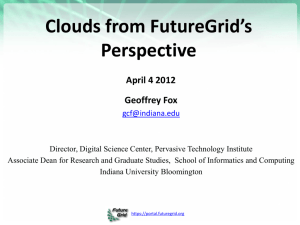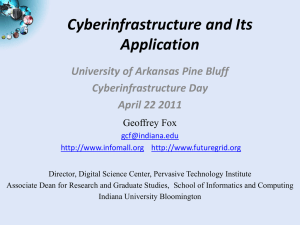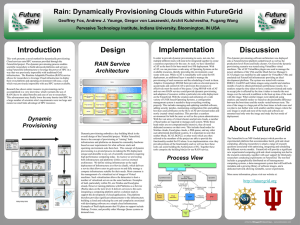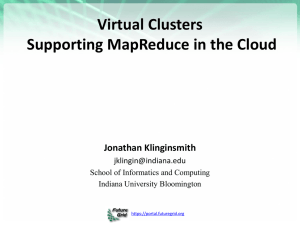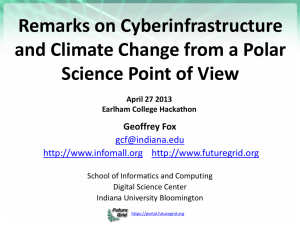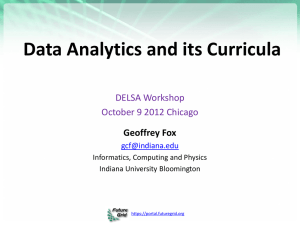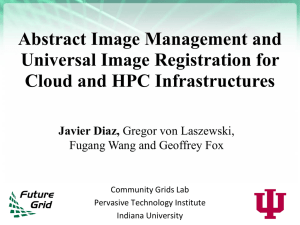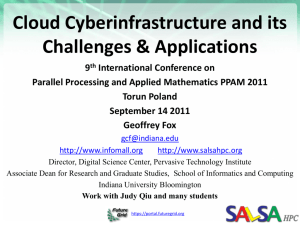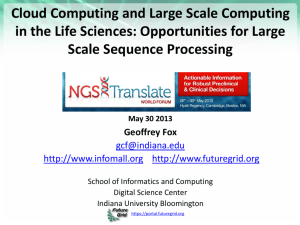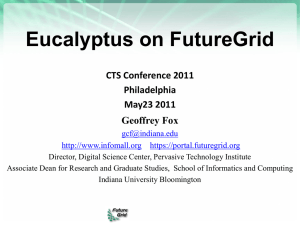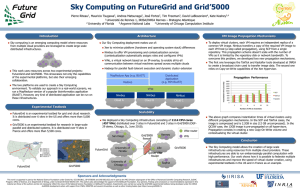Geoffrey Fox
advertisement
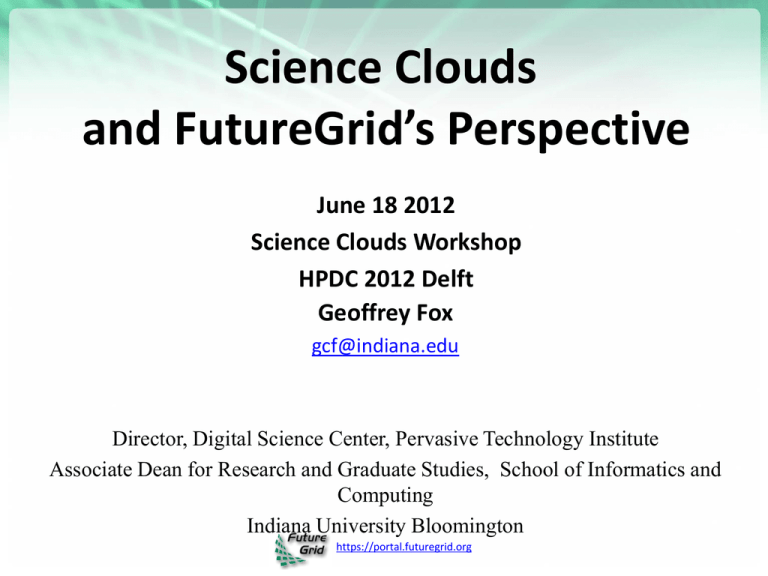
Science Clouds and FutureGrid’s Perspective June 18 2012 Science Clouds Workshop HPDC 2012 Delft Geoffrey Fox gcf@indiana.edu Director, Digital Science Center, Pervasive Technology Institute Associate Dean for Research and Graduate Studies, School of Informatics and Computing Indiana University Bloomington https://portal.futuregrid.org Panel Questions • Brief description of the project – goal, testbed infrastructure, target users/application. • Unique science cloud characteristics - how is/are your science application(s) distinct from traditional commercial cloud applications? • Discuss some of the challenges and findings from the project • Discuss any practical findings that are useful for cloud admins, developers and/or users. • Discuss future research, development and challenges for wider adoptability of cloud environments for use of science based on your project experience. https://portal.futuregrid.org 2 What is FutureGrid? • FutureGrid modeled on Grid5000 • FutureGrid mission is to enable experimental work that advances: a) Innovation and scientific understanding of distributed computing and parallel computing paradigms, b) The engineering science of middleware that enables these paradigms, c) The use and drivers of these paradigms by important applications, and, d) The education of a new generation of Nimbus 56.90% Eucalyptus 52.30% students and workforce on the use of HPC 44.80% these paradigms and their applications. Hadoop 35.10% MapReduce 32.80% • The implementation of mission includes XSEDE Software Stack 23.60% Twister 15.50% • Distributed flexible hardware OpenStack 15.50% OpenNebula 15.50% with supported use Genesis II 14.90% Unicore 6 8.60% • Identified IaaS and PaaS “core” software gLite 8.60% with supported use Globus 4.60% Vampir 4.00% FutureGrid Usage • Outreach Pegasus 4.00% PAPI 2.30% • ~4500 cores in 5 sites https://portal.futuregrid.org FutureGrid: Inca Monitoring https://portal.futuregrid.org 5 Use Types for FutureGrid • 220 approved projects June 17 2012 – https://portal.futuregrid.org/projects • Training Education and Outreach (8%) – Semester and short events; promising for small universities • Interoperability test-beds (3%) – Grids and Clouds; Standards; from Open Grid Forum OGF • Domain Science applications (31%) – Life science highlighted (18%), Non Life Science (13%) • Computer science (47%) – Largest current category • Computer Systems Evaluation (27%) – XSEDE (TIS, TAS), OSG, EGI • Clouds are meant to need less support than other models; FutureGrid needs more user support ……. https://portal.futuregrid.org 5 https://portal.futuregrid.org/projects https://portal.futuregrid.org 6 Recent Projects https://portal.futuregrid.org 7 Distribution of FutureGrid Technologies and Areas Nimbus 56.90% Eucalyptus 52.30% HPC 44.80% Hadoop 35.10% MapReduce 32.80% XSEDE Software Stack 23.60% Twister 15.50% OpenStack 15.50% OpenNebula 15.50% Genesis II 14.90% Unicore 6 8.60% gLite 8.60% Globus 4.60% Vampir 4.00% Pegasus 4.00% PAPI 2.30% • 220 Projects • Hard to support multiple IaaS on same cluster • Dynamically provision Education 9% Technology Evaluation 24% Interoperability 3% Life Science 15% https://portal.futuregrid.org other Domain Science 14% Computer Science 35% Using Science Clouds in a Nutshell • • • • • • • High Throughput Computing; pleasingly parallel; grid applications Multiple users (long tail of science) and usages (parameter searches) Internet of Things (Sensor nets) as in cloud support of smart phones (Iterative) MapReduce including “most” data analysis Exploiting elasticity and platforms (HDFS, Object Stores, Queues ..) Use worker roles, services, portals (gateways) and workflow Good Strategies: – – – – – – Build the application as a service; Build on existing cloud deployments such as Hadoop; Use PaaS if possible; Design for failure; Use as a Service (e.g. SQLaaS) where possible; Address Challenge of Moving Data https://portal.futuregrid.org 9 Cosmic Comments • Are clouds different from Grids: in principle or in practice? • Does a “modest-size private science cloud” make sense – Too small to be elastic • Should governments fund use of commercial clouds (or build their own) – Most science doesn’t have privacy issues motivating some private clouds • Does Cloud + MPI Engine cover the future? • Most interest in clouds from “new” applications such as life sciences • Recent cloud infrastructure (Eucalyptus 3, OpenStack Essex) much improved • More employment opportunities in clouds than HPC and Grids; so cloud related activities popular with students • Science Cloud Summer School July 30-August 3 – Part of virtual summer school in computational science and engineering and expect over 200 participants spread over 9 sites • Science Cloud and MapReduce XSEDE Community groups https://portal.futuregrid.org 10
